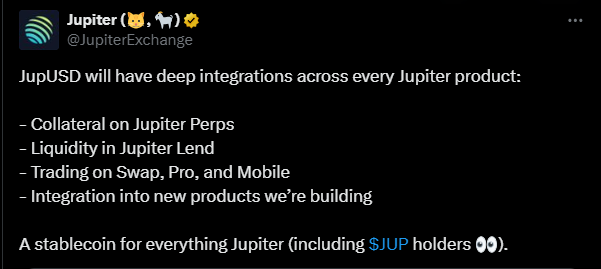TL;DR
- Jupiter, Solana's leading DEX aggregator, is launching JupUSD in partnership with Ethena Labs.
- The stablecoin goes live in mid-Q4 2025, powering trading, lending, and perpetual markets across the Jupiter ecosystem.
- Backed initially by Ethena's USDtb, with future integration of USDe for yield optimization.
- Around $750 million in existing stablecoins on Jupiter will be gradually converted to JupUSD.
- Designed to make Jupiter more self-sufficient, unified, and aligned with Solana's growing DeFi stack.
The Solana-based DEX aggregator has announced JupUSD, a new stablecoin created in collaboration with Ethena Labs, the team behind USDe and USDtb. The launch, planned for mid-Q4 2025, marks a major shift in how Jupiter intends to handle liquidity, collateral, and user interaction across its entire ecosystem.
Instead of relying on third-party stablecoins like USDC or USDT, Jupiter wants something that fully aligns with its own products and community. JupUSD will act as a native dollar layer for everything inside Jupiter - from perpetual futures and lending pools to everyday swaps and mobile trades.
Or as the team described it in their announcement:
The message is simple - JupUSD isn't just another stablecoin. It's an attempt to connect all corners of the "Jupiverse" with a unified, yield-backed asset built for Solana's fast-growing DeFi ecosystem.
Collateral & Yield Strategy
At launch, JupUSD will be 100% collateralized by Ethena's USDtb, a dollar-pegged token backed by short-term U.S. Treasury assets.

Over time, Jupiter plans to introduce USDe, Ethena's synthetic dollar, as secondary collateral. This move is meant to optimize yield rates for JupUSD holders and better leverage Ethena's infrastructure. The partnership is being built on Ethena's white-label stablecoin-as-a-service infrastructure, which allows other protocols to launch branded stablecoins using Ethena's collateral management, mint/redeem logic, and auditing framework.
Liquidity Realignment: $750M Shift
One of the more striking components of the plan is Jupiter's intent to convert roughly $750 million in USDC and other stablecoins currently held in its liquidity pools into JupUSD gradually. This move would help bootstrap JupUSD's liquidity and simultaneously reduce dependence on external stablecoins, making the Jupiter ecosystem more self-reliant.
Broader Context: White-Label Stablecoins & DeFi Trends
JupUSD is part of a larger trend: white-label stablecoins. As the stablecoin market grows past $300+ billion in total capitalization, more protocols are choosing to issue their own tokens using shared infrastructure.
Ethena already supports other ecosystems via its whitelabel model. The advantage? Protocols don't need to build complex stablecoin logic from scratch-they can plug into Ethena's tested system. This also mirrors strategies by other DeFi protocols launching native stablecoins (e.g. Aave's GHO, Curve's crvUSD), pushing liquidity and fee flows inward rather than out to external stablecoins.
Risks, Challenges & What to Watch
While the proposition is promising, several risks and challenges must be considered:
1. Stability & peg management
Ensuring JupUSD stays pegged to $1 under stress is critical, especially when collateral transitions to include USDe.
2. Security & auditing
Mint-redeem and collateral logic must be securely audited before launch - a flaw could undermine trust.
3. User adoption & trust
Liquidity must flow into JupUSD for it to be useful across Jupiter's products. Users must feel confidence in switching from established stablecoins.
4. Regulatory scrutiny
As stablecoin frameworks tighten globally (e.g., via the GENIUS Act in the U.S.), new stablecoins will face regulatory review, especially those backed by real-world assets.
5. Collateral dynamics
The future shift to USDe introduces complexity; synthetic assets come with additional volatility and hedging risk.
Outlook: Will JupUSD Shift the Solana Stablecoin Landscape?
JupUSD has potential to shake up how liquidity works on Solana. If successful, Jupiter becomes more self-sufficient in dollar liquidity and also JupUSD may draw more capital into the Solana ecosystem. It could set a model for other chains and aggregators to issue native stablecoins
But success depends on execution. If JupUSD fails to maintain stability or liquidity, it could become just another experiment. For now, the plan is clear: mid-Q4 2025 is the target, audits and testing are underway, and the stablecoin market is watching.
READ MORE : What is COTI V2: Revolutionizing Blockchain Privacy with Garbled Circuits











